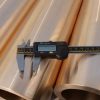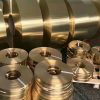
Stamping, forging and spinning are commonly used metal parts machining processes. Do you know the similarities and differences between them?
The Define Of Stamping,Forging And Spinning
Metal spinning/metal stamping/metal forging is a process used by manufacturers to process axisymmetric metal parts. This process is efficient and versatile. In China, our partner Be-cu.com has provided customers in aerospace, commercial, medical and defense industries with more than 30 years of high-quality metal manufacturing services.
What Is Metal Stamping
Stamping is a processing method with high efficiency, low consumption and low technical requirements. Stamping parts are not only used in large-scale manufacturing. If you pay attention, you will find that there are many stamping parts around us (for example, 80% of the parts in watches are stamping parts). Even if you have not learned the knowledge of stamping, give you some stamping parts, you will find several obvious characteristics:
- (1) Most stamping parts are thin sheets or layered sheets (plates or profiles, pipes, etc.);
- (2) The vast majority of multi stamping parts are formed at one time without any trace of secondary processing
- (3) They are all metal pieces
In fact, from a professional point of view, the stamping process is a processing process to separate the raw material sheet according to a certain shape and generate metal molding(Include laser cutting and sheet metal fabrication) deformation to obtain the desired shape through the stamping die and stamping equipment. For a specific die, the shape, size and performance of the stamping parts are basically consistent.
- Stamping Mold:Generally speaking, the stamping die is the “template” used for stamping. One template can only punch one type of stamping parts. Different types of stamping dies need to be selected according to the different sizes, materials and shapes of the required stamping parts
- Stamping Equipment: Stamping equipment is actually the so-called press. Stamping is the forming process method of workpieces (stamping parts) with required shape and size by exerting external force on plates, strips, pipes and profiles to cause plastic deformation or separation. It can be imagined that the force required for stamping cannot be achieved without the pressure of large machinery, which requires a press. There are also many kinds of presses. The most common one is hydraulic press: a machine that uses hydrostatic pressure to process metal, plastic, rubber, wood, powder and other products. It is commonly used in pressing process and pressing forming process, such as forging, stamping, cold extrusion, straightening, bending, flanging, sheet drawing, powder metallurgy, press fitting, etc. Hydraulic press is divided into hydraulic press and hydraulic press.
What Is Metal Forging
Forging has a long history in China, which has been continued by the way of manual workshop production. Probably at the beginning of the 20th century. It gradually appeared in the railway, military, shipbuilding and other industries in the way of mechanical industrialization. The main sign of this transformation is the use of machines with strong forging ability.
Metal Forging is widely used in automobile manufacturing. With the progress of science and technology, the requirements for workpiece accuracy are constantly improved, and precision forging technology, which has the advantages of high efficiency, low cost, low energy consumption and high quality, is more and more widely used. According to the different deformation temperatures during metal plastic forming, precision cold forging can be divided into cold forging forming, temperature forming, sub hot forging forming, hot precision forging forming, etc. The automobile parts produced include: automobile clutch engagement ring, input shaft parts of automobile transmission, bearing ring, sliding sleeve series of automobile constant velocity universal joint, automobile differential gear, automobile front axle, etc.
Forging is a processing method that uses forging machinery to exert pressure on metal blank to make it produce plastic deformation to obtain forgings with certain mechanical properties, certain shapes and sizes. Forging (forging and stamping) is one of the two major components.
Forging can eliminate as cast porosity and other defects produced in the smelting process of metal, optimize the microstructure. At the same time, due to the preservation of complete metal streamline, the mechanical properties of forgings are generally superior to castings of the same material. For important parts with high load and severe working conditions in related machinery, forgings are mostly used, except for simple rolled plates, profiles or weldments.
What Is Metal Spinning
Speaking of ceramic art, I believe that everyone will have such a scene in mind: holding a ball of mud with both hands, during the rotation of the machine, through the stretching or squeezing of both hands, the mud gradually becomes a variety of ceramics. Did you know that hard metals can also be made into various products through similar processes. This miraculous process is called “spinning”.
Metal Spinning is to fix the flat plate or hollow blank on the die of the spinning machine. When the blank rotates with the main shaft of the machine, it is pressed on the blank with a spinning wheel or a driving rod to cause local plastic deformation. Spinning is a special method of sheet metal forming, which can complete complex geometric features of various complex sheet metal parts. The spinning method can be used to complete the geometric features of complex sheet metal parts such as drawing, flanging, necking, bulging and crimping.Stamping VS Forging VS Spinning,What is their common point and differences?
Common Points Of Stamping, Forging And Spinning
The principle is that the press exerts pressure on the metal in the mold, and the efficiency is very high, and the processing speed can be very fast; They all need molds. Generally, molds are expensive to process, but once they are successfully processed, they can be mass produced.
The technical requirements are high. Generally, master die technology is required, which requires greater investment. Forging requires greater investment.
Most of the processing machines are mechanical or hydraulic presses. The layman looks similar and has many similarities, but there are many differences in equipment structure and practical application.
It is a kind of processing technology. It does not produce its own independent products. Stamping, forging and spinning provide several or even hundreds of products for downstream users. They are only a small link in the middle of the industrial chain, subject to downstream demand, and generally do not have pricing power.
Differences Between Stamping, Forging And Spinning
Stamping is basically cold processing, of course, there is also hot stamping, but less; Forging is basically hot, which requires heating the processing materials and cold forming, but heat treatment is required after the completion; Spinning generally focuses on cold processing, but during the processing, the material itself will become hot.
Forging is volume deformation, metal structure change, and processing is basically three-dimensional stress parts, such as the crankshaft and connecting rod in the engine; Stamping is the deformation of sheet metal. Generally, it does not involve the change of internal crystals. It is just the stretching deformation of the thickness of sheet metal. The processed stampings are either stressed or not, and have a wide range of applications; Spinning has the deformation mode of stamping and forging, which can not only change the volume (shape) of the material, but also change the thickness of the material through stretching.
The working environment of the forging workshop is relatively harsh and messy, accompanied by huge noise, as well as the smell of burning in the heating industrial furnace, cooling graphite, oxide scale and other smells; The stamping workshop is relatively good, but due to the up and down collision of the stamping machine, the noise is not small; The aluminum/brass/copper spinning workshop environment is relatively good. The spinning machines are basically equipped with protective doors, which can isolate part of the noise, and there is little or no waste generated.
From the perspective of workers, traditional factories are very boring, stamping automation is very common, forging is relatively difficult, spinning mostly depends on China CNC machining technology, and the requirements for workers are not very high.
No matter what kind of processing technology, it belongs to the manufacturing industry. Manufacturing industry is an essential and important basic industry, which is related to people’s livelihood. Therefore, we should make full use of the characteristics and advantages of each process to manufacture products with high requirements and improve the overall industrial capacity of the country.
Link From:Beryllium Copper China






